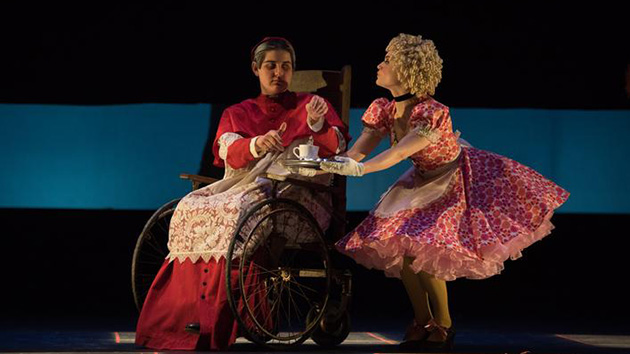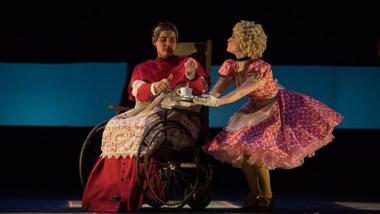
From SFCV Emerging Writers Program
Oberlin Conservatory’s March 13 production of Mozart’s Italian opera La finta giardiniera (“The pretend garden-girl”) eschewed conventions in favor of bunnies on bikes. Director Jonathon Field, the school’s associate professor of Opera Theater, is known for his nontraditional visions: His insertions of iPads, alien costumes, and even the YouTube sensation “Gangnam Style” into previous Oberlin operas are legendary.
This season, he transformed La finta into a down-the-rabbit hole absurdist comedy, filling Hall Auditorium with peals of laughter. La finta is already ridiculous for its melodramatic plot: It is the tale of a countess (Rebecca Achtenberg) who longs to be reunited with her husband (Daveed Buzaglo) even though he stabbed her in a fit of jealous rage and left her, presuming she was dead. She sets out to win him back, her trusty servant (Aaron Keeney) in tow. The story evolves into entwined circles of unrequited love, all of which are miraculously resolved at the end.
This opera’s terminally silly libretto could easily alienate audiences. But Field’s direction embraced and heightened the ludicrousness until we came to love the characters’ lines for their inanity.
With performers dressed in full-body bunny suits and moving around the stage in slow motion, Field concocted an enthralling habitat of Alice in Wonderland-like fantasy. The first act set was minimal, featuring occasional furniture and a background of only scrims and curtains. In the final two acts, staircases disguised as mounds of earth descended onto each side of the stage. Long shower curtains with enormous flowers hung in the back so the action appeared to be happening inside a hole in a garden.
The rabbits, who were invisible to the other characters, maneuvered set pieces, curtains, props, and even actors. The entire production seemed to be run by these rabbits, the characters merely acting as puppets in their game. And while the human marionettes often moved of their own free will, it was easy to believe there could be other puppeteer rabbits to which even the audience was blind. The entire production seemed to be run by these rabbits, the characters merely acting as puppets in their game.
To pull off Field’s aesthetic, the cast needed to fully embrace the hyperbole already built into their roles, and they did so with flair. Particularly notable was soprano Elissa Pfaender as Arminda, a dark seductress. She exuded power in every detail of her body language and voice. During her aria, “Si promette facilmente,” she hit her highest note with a vitality that seemed to stir every square inch of air in the hall. Then she paused and emitted an in-character smirk, knowing she had everyone on stage and in the audience under her spell. In a later sequence, she manically smeared lipstick over her face. Her widened eyes and slow movements were subtle and chilling.
The entire cast managed to pull off similarly unusual tasks. As the countess’ servant, Keeney was outfitted as a clown, complete with orange wig, red nose, and white face paint. Don Ramiro (Perri DiChristina), a suitor of Arminda’s, was a cross between a fairytale prince and a modern dictator, with a sash, epaulets, and incongruously chic sunglasses.
The ensemble played their comical gimmicks well, but their voices were even more impressive. Mozart’s score is saturated with almost impossibly rapid scales and arpeggios. He may have been only 18 when he composed La finta, but he refused to accept anything less than virtuosity from his singers. The cast conquered the musical difficulties with agility. Pfaender, DiChristina, and Katherine Skayhan, playing the frivolous maid Serpetta, were particularly precise as they steered through the vocal obstacle course. DiChristina brought a pure tone to the role originally written for a mezzo-soprano castrato.
The cast also navigated the complicated rhythms with minimal harpsichord accompaniment. Harpsichordist Javier Gonzalez played precisely, but his music acted less as a cue and more as a marker for the singers. During the complete vocal numbers, the orchestra, conducted by Raphael Jiménez, offered more steady support while achieving an ideal balance with the singers.
From beginning to end, La finta was consistently amusing, but such a wild interpretation raises the question of how far is too far? Audiences tend to find meaning by connecting with characters. When they are implausible and controlled by giant rabbits, do the characters seem too foolish and unrealistic to elicit our sympathy? La finta didn’t offer much of a chance for viewers to engage with the characters on a wide emotional spectrum, but it was a miraculously compelling show from start to finish. Opera is known for its sense of spectacle. The La finta ensemble delivered that spectacle with a rare irreverence that was delightful to behold.

